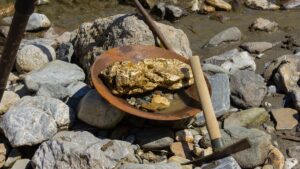Tim Treadgold: Red 5 uncovers 2m ounces of ‘missing’ gold

Pic: Tyler Stableford / Stone via Getty Images
Old mines. New tricks.
That might sound like the opening line of a joke but it happens to be true of what the oddly-named Red 5 (ASX:RED) is doing at two old mines in WA where at least two million ounces of “missing” gold have been found after more than 30 years of production.
The trick, in the case of the old Tarmoola mine which is now called King of the Hills (KOTH), has been to flip the direction of exploration drilling to test for gold along a section of the project known as the Eastern Margin Contact.
The result has been nothing short of spectacular with an initial Eastern Margin Contact resource of 28.7 million tonnes of material assaying 2 grams a tonne identified and with much more likely as Red 5 expands its search and rewrites the understanding of the geology at KOTH.
Looking deeper
Originally developed in 1990 as a conventional WA-style goldmine focussed on a main fracture in the ground through which gold-rich mineralised fluids flowed creating a “vein” of gold, it now looks as if there were other geological events which saw gold pushed into smaller cracks running off the main vein into the host rock, a material called granodiorite.
Described as tension fractures they are believed to be related to a compression event which created a different mechanism for trapping gold in narrow “veinlets” that were ignored by early explorers and in most cases not even assayed.
- Subscribe to our daily newsletter
- Bookmark this link for small cap news
- Join our small cap Facebook group
- Follow us on Facebook or Twitter
The difference between what earlier owners did at KOTH, including Mt Edon Mines, Sons of Gwalia and Saracen Mineral Holdings, and what Red 5 is planning, is a shift from a narrow focus on the main vein to examining the potential for a bulk-mining operation.
Rather than trying to extract the minimum amount of gold-bearing ore to keep processing costs down, a bulk mine takes everything and in the case of KOTH everything could be lot because the exploration phase using the new geological model has just begun.
New beginnings
Some investors might remember that it was back in September 2017 that Stockhead took its first look at Red 5, a company hammered by changing mining laws in the Philippines which forced it to return to Australia in what turned out to be a rather clever deal.
In a complex three-way transaction Red 5 acquired the Darlot goldmine from South Africa’s Gold Fields and KOTH from Saracen. Both vendors took a mix of cash and shares and now hold big stakes in Red 5; 19.9 per cent to Gold Fields and 10.5 per cent to Saracen, with US fund manager Franklin Templeton (through Franklin Resources) having a 14.6 per cent stake.
That strong shareholder base is one reason to take a fresh look at Red 5 which is considering whether to restart work at the Siana goldmine in the Philippines after receiving government approval to develop a new tailings dam.
Coming home to WA (with a side trip to South Africa)
Tempting as it might be to return to Siana which has the potential to produce 504,000oz over an eight-year campaign at an all-in sustaining cost of up to $US840/oz, there might be bigger and better options at KOTH and Darlot.
Earlier this month the managing director of Red 5, Mark Williams, announced the start of a strategic review to evaluate the economics of a bulk underground mine or a big open pit (or both) with purpose-built processing plant.
“This initial bulk resource at KOTH is a game changer for Red 5,” Williams said.
“Based on the drilling completed to date and assessing only a portion of the broader granodiorite (a very hard rock similar to granite) contact zone, the size and scale of this resource gives us more confidence that KOTH can ultimately support a large-scale, bulk-mining operations.”
Do your stockwork
One of the major considerations in a mining study will be the cost of crushing granodiorite which could have a significant effect on the economics of the project.
While not an exact comparison, the Eastern Margin Contact which is breathing new life into KOTH can be loosely compared with the type of mineralisation associated with the porphyry rocks that host much of South America’s copper in narrow veins and hairline fractures producing a structure called stockwork.
The vast volume of material in some porphyrys mean they can be economic to mine even if the copper grade drops below 0.2 per cent. And while Red 5 has not made the porphyry comparison, the early reports have included the stockwork description, which could cause some observers to draw the connection with porphyry.
King of the Hills
Whatever the geological explanation it appears that the re-interpretation of the gold at KOTH is just beginning as the Eastern Margin Contact, which is located adjacent to the existing mining areas, extends for a distance of 2.2km, and down to a depth of 130 metres below the southern end of the existing pit and 300m deep in the north.
It could eventually prove to be much bigger than even those impressive measurements with the interpreted contact measuring 4km long, 1.8km wide and more than 500m deep – with Red 5 describing it as “a very large-scale exploration opportunity”.
Some of the assays from the drilling which switched to look for high-grade veins and stockwork in the granodiorite including eye-catching 330m at 1.7g/t, 234m at 2g/t and 127m at 1.9g/t.
It is also understood that drill core not assayed by previous owners of KOTH has recently been analysed and has returned encouraging gold grades.
On the market, Red 5 shares have started to react to the re-awakening of KOTH, rising from a low of 5c in late October to recent trades at 7.8c which values the company at a relatively modest $97 million.
UNLOCK INSIGHTS
Discover the untold stories of emerging ASX stocks.
Daily news and expert analysis, it's free to subscribe.
By proceeding, you confirm you understand that we handle personal information in accordance with our Privacy Policy.








